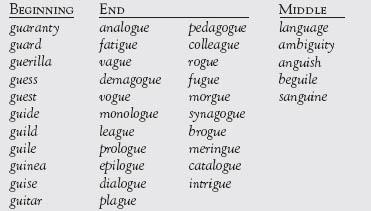The Complete Guide to English Spelling Rules (20 page)
Read The Complete Guide to English Spelling Rules Online
Authors: John J Fulford

Spelling rule #3: The
g
is hard before
a, o, u
or a consonant:

The
g
is always hard when it is the final letter in a word:

The
ng
combination is often a problem. The hard
g
is pronounced softly but clearly. In words like
sing, singing, playing,
etc., it is pronounced so softly that it is barely audible.

While the hard and soft rule is quite clear and logical, and it is valid for the vast majority of words, English being the wonderfully complex language it is gives us exceptions. These are discussed in the following paragraphs.
Spelling rule #4: Sometimes the
g
is hard before the letters
e
and
i
.
H
ARD GE WORDS:

H
ARD GI WORDS:

Note that mathematicians and computer experts sometimes argue among themselves regarding the word
gigabyte
. Since it does not come from the English word
gigantic
but from the Greek word
gigas (“giant”),
it is properly pronounced with two hard
g
’s.
The words in this next group appear to be anomalies, but they actually form a special subgroup composed of single syllable words that end in
ing
. No other letter is added to keep the
g
hard, even though the suffixes start with
e, i,
or
y
.

Apart from this handful of semi-hard
ge
and
gi
words, there are no other exceptions among commonly used words.
Spelling rule #5: There are occasions when a word that ends in
g
must be followed by an
i
or an
e
. If it is a hard
g
, then confusion might arise because the
g
would become soft. In such cases a
u
is added between the
g
and the softening vowel.
The
gu
is used to keep the
g
hard, no matter what letter follows. A wide variety of words use the
gu
, which can be found at the beginning of a word, at the end, and sometimes in the middle.

It is obvious that at least half a dozen words in the list above do not really need the
gu
. For example, the
a
in
guarantee
and in
guard
is not a soft vowel. Similarly,
league
and
colleague
do not need the
ue
.
However, some modernization has occurred. Over the past few years, many
ogue
words have lost the
ue
and now end with a simple
g
:

H
ere is one of those spelling rules that we all remember quite well, though we sometimes get a little confused when it comes to actually applying the rule and remembering the exceptions. The rules are quite simple and very logical and have few exceptions. The rule is applied when forming plurals and when adding suffixes.
Spelling rule #1: If there is a vowel before the
y
, add the
s
or the suffix:

Spelling rule #2: If there is a consonant before the
y
, change the
y
to an
i
before adding the plural
es
or the suffix:

But if the suffix begins with an
i
, then the
y
has to remain or we would have a double
i
which is extremely rare in English: